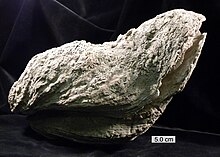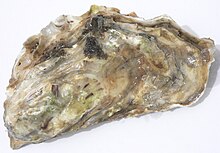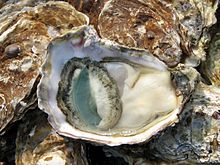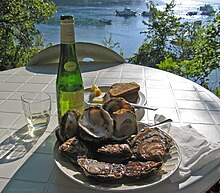Oysters
| Oysters | ||||||||||
|---|---|---|---|---|---|---|---|---|---|---|

Pacific oyster ( Crassostrea gigas ) |
||||||||||
| Systematics | ||||||||||
|
||||||||||
| Scientific name | ||||||||||
| Ostreidae | ||||||||||
| Rafinesque , 1815 |
The oysters (Ostreidae) are a family of mussels (Bivalvia). The scientific name Ostreidae is derived from the name of the genus Ostrea (plural to Greek ὄστρεον ostreon "shell", "oyster"). You can find oysters around the world on the rocks of shallow tidal waters , but there is also oyster farming .
Oysters have existed for 250 million years, the number of known fossil species is greater than the number of recent species. Oysters have an important ecological function in coastal waters . They filter around 240 liters of water through their bodies every day to filter out nutrients. They also serve as prey for many marine life , whereas they try to protect themselves with an extraordinarily massive shell.
Oysters are of interest to humans as food , although only a few types of oyster are considered to be edible. These “culinary oysters”, whose weight is mostly between 50 and 150 g, are given priority in the following. The first specimens were eaten by people in the Red Sea 125,000 years ago. Other types of oysters - called pearl oysters - have the ability to produce pearls . Pearl oysters are mainly found in the Far East. The shells of the oysters can also be used.
Systematics
External system
Oysters belong to the tribe of molluscs (Mollusca), more precisely to the sub-tribe of shell molluscs ( Conchifera), and of course to the class of mussels (Bivalvia). Together with several other superfamilies, they form the order of the Ostreida.
Internal system
- Genera (selection)

The most important genera of the oyster family (Ostreidae) are:
- Crassostrea
- Cryptostrea
- Dendostrea
- Lopha
- Magallana
- Ostrea - the species-richest genus with around 120 known fossil and recent species
- Ostreola
- Saccostrea
- Teskeyostrea
- Types (selection)
A selection of the most important species and their global market share in 2003:
| Surname | Scientific | proportion of |
|---|---|---|
| Pacific oyster | Crassostrea gigas | 93.7% |
| American oyster | Crassostrea virginica | 5.1% |
| Slipper oyster | Crassostrea iredalei | 0.3% |
| European oyster | Ostrea edulis | 0.2% |
| Sydney rock oyster | Saccostrea glomerata | 0.1% |
| Mangrove oyster | Crassostrea rhizophorae | 0.1% |
| New Zealand oyster | Ostrea lutaria | <0.1% |
| Chilean oyster | Ostrea chilensis | <0.1% |
| Gasar oyster | Crassostrea gasar | <0.1% |
| Olympic oyster | Ostrea conchaphila | <0.1% |
| Cortez oyster | Crassostrea corteziensis | <0.1% |
| Lid oyster | Saccostrea cuccullata | <0.1% |
| Indian oyster | Crassostrea madrasensis | <0.1% |
| Portuguese oyster | Crassostrea angulata | <0.1% |
The Portuguese oyster ( Crassostrea angulata ) is a problematic case. It is occasionally assumed that it is not a species of its own, but a variety of the Pacific oyster ( Crassostrea gigas ). However, recent studies indicate that there are two different types.
anatomy
Bowl
The oyster protects itself against its numerous enemies by an exceptionally thick, hard and sharp-edged shell. In the oyster, the two shell flaps are not the same. The lower = left shell flap is clearly arched, in it lies the soft body. This shell grows on the underground when the oyster is young. It then remains immobile for life. The upper, right half of the shell is rather flat. It serves as a lid and can be opened and closed. When closed, the shell is practically completely waterproof. This allows the oyster to survive out of the water for up to two weeks without drying out.
The shells consist mainly of calcium carbonate . However, pure lime does not have the breaking strength necessary to ward off enemies. The oyster therefore builds the shell from two substances: the calcium carbonate crystals and a substance called conchin (also: conchiolin ). This organic mixture of proteins has the task of sticking the lime crystals together. This creates a very break-proof and shock-proof shell.
The shell is made up of three layers. The outermost layer exposed to the environment (periostracum) is particularly strong. Depending on the exact chemical composition, it has different colors (gray, brownish or greenish). A thin, chalk-like layer (ostracum) of tiny calcite crystals follows within this shell . The innermost layer is finally the mother-of-pearl layer (hypostracum), which consists of aragonite . It is more elastic than the outer layers and prevents cracks from spreading in the shell.
The two shell halves are connected by a hinge (lock strap or ligament ). In the case of elongated oysters, it is on the tapered side of the shell. The hinge is built in such a way that the shell is open when there is no force; the closing requires an exertion from the mussel. Inside the hinge there is a rubber-like layer (Resilium) that is squeezed together when the shell is closed. If the mussel relaxes the sphincter, the resilium pushes the two halves of the shell apart again.
Soft body
The soft body is completely embedded in a thin “coat” that only has openings for water absorption and digestion. When the oyster is open, the coat can be seen as the outermost lobe near the edge; he is sometimes called "beard". The lobe of the mantle regulates the flow of water to the gills . In addition, it serves as a sensor : when touched, it triggers the immediate closing of the shell.
The coat also provides for the structure of the shell. In the mantle there are special cells called epithelial cells that are able to secrete calcium carbonate and conchin. Depending on the mixing ratio of these two substances, the coat can produce the different layers of the shell. The epithelial cells at the edge of the mantle lobes build the two outer layers (periostracum and ostracum) of the shell. The inner areas of the mantle take care of the growth of the mother-of-pearl layer (hypostracum). Those parts of the mantle that are close to the hinge supply the ligament with a special conchin mixture and keep it always functional.
The coat also uses the ability to form a layer of mother-of-pearl to combat intruders. If organic or inorganic substances get into the oyster, the epithelial cells immediately coat them with a layer of mother-of-pearl and thus render them harmless. A large, spherical pearl is only created with very special oyster species . This pearl formation is extremely rare in culinary oysters. If a pearl does form, it is hardly ever larger than one or two millimeters, it is unsightly and worthless. Such small pearls are usually not noticed when "slurping". It is almost impossible to discover a valuable pearl when opening a culinary oyster.
organs
The largest organ of the oyster in terms of surface area are the gills . They have a double function: First, they are used for breathing by absorbing oxygen from the water and transferring it into the bloodstream. Second, the gills are used for food intake. They are covered with innumerable tiny hairs (cilia) that move quickly and feed plankton - mainly microscopic algae - to the gills . The water throughput is extraordinarily high: the oyster carries up to 240 liters of water through its body every day. In the gills are mucous glands that glue the tiny food particles together. These small packets of mucus are then transported further towards the mouth by two pairs of muscles.
The oyster mouth has an antechamber in which indigestible substances are excreted. The mouth also regulates the amount of food that is fed to further digestion .
Finally, the food reaches the stomach, where it is stirred by a flexible, sharp-edged "crystal". Then enzymes ensure that the food is converted into the body's own substances. Indigestible food is transported into the relatively long, tortuous intestine and expelled from there via the rectum and anus.
Immediately next to the sphincter muscle (towards the hinge) is the heart of the oyster. It has two chambers (atrium and heart chamber) and pumps the milky blood of the oyster around the body.
Next to the heart is the sex organ , the gonads. The oyster is hermaphroditic , so the sexual organ can alternately produce sperm or eggs. (For details see under "Reproduction".)
The most powerful body part of the oyster is the sphincter, it can make up up to 40 percent of the body mass. The sphincter muscle penetrates the soft body vertically and is anchored to both the upper and lower shell halves. It is extraordinarily powerful - it is not possible to open a healthy oyster without the aid of a tool. The muscle is made up of two types of tissue . Some muscle strands are able to close the shell at lightning speed in the event of danger. The other strands are designed for endurance, they can keep the shell closed for days and weeks. The sphincter can only close the shell, but not open it - this is done by the hinge (ligament).
In contrast to other mussels , the adult oyster does not have a foot and is not able to move about in any way. With the exception of simple pressure sensors, oysters have no sensory organs , they have no brain and only rudimentary approaches to a nervous system . So they are not aware of their environment.
Reproduction
Hermaphroditism
Oysters are bisexual ( hermaphroditism ), although the specific form of this bisexuality is different for the different oyster species. The Pacific oyster initially grows as a male and remains so for the first year. From the second year onwards, part of the population changes into females and then stays that way. In theory, the Pacific oyster could change its sex multiple times, but it usually doesn't. In contrast, the European oysters make use of this possibility. In the first year they are predominantly - but not exclusively - male and then change their gender again and again , they are "consecutively rhythmic hermaphrodites".
It is not uncommon for an unbalanced ratio of males and females to be found in an oyster population. This ratio is determined by environmental factors , especially the food supply. If the supply is very abundant, more females are formed and there are thus more offspring.
Spawning and fertilization
Oysters lay their eggs in summer, with the water temperature being a trigger factor. The European oyster spawns in relatively cool water of 15 to 17 degrees. In Europe - including Northern Europe - these temperatures are almost always reached in summer near the coast . The European oyster reproduces naturally relatively easily. In contrast , the Pacific oyster , which comes from Asia , only spawns at higher temperatures of 19 to 23 degrees. These temperatures are often not reached in Northern Europe, so spawning does not occur. For this reason, among other things, many oyster cultures are stocked with seed oysters from farms in cool regions.
The female Pacific oyster produces 50 to 100 million eggs per spawning process. These are washed out by the oyster by jerking the shell open and closed. The male oysters release sperm at the same time , fertilization occurs in the open sea . The females can spawn several times in a summer . The European oyster only produces 0.5 to 2 million eggs, but protects them better. She does not eject the eggs immediately, but deposits them in the shell between the coat and the mother-of-pearl layer. Since the oyster is constantly sucking in water, sperm also gets inside and fertilizes the eggs.
Larvae
In the case of the European oyster, the larvae hatch within the shell after a short time, remain there for about ten days and are then expelled. In the Pacific oyster, the larvae hatch in the open sea within 48 hours . Only about one percent of the animals survive the larval stage, which is enough for a reproduction given the enormous number of larvae at the beginning. In the course of two to three weeks, the animals develop into ciliated larvae ( Veliger ). They develop a wafer-thin shell, a tiny foot and a primitive "eye" that can differentiate between light and dark.
metamorphosis
After about three weeks, when the larvae are around 0.3 millimeters in size, they look for a suitable substrate on which to anchor themselves with their feet. Then the metamorphosis to the shell begins . The left, stationary bowl becomes the bulbous lower one, the right one the flat upper one. Body parts such as the foot, eye and eyelashes recede and are replaced by the gills and finally by the rest of the soft body. The metamorphosis is a great burden for the young oysters and leads to death in many animals.
Growth and age

The surviving oyster babies (English: late , French: naissain ) reach a size of 10 to 15 millimeters after two months. How fast the oysters grow depends on the environmental conditions . A high food supply leads to rapid growth. In contrast, growth slows down when the population is high, i.e. when there is strong food competition. In Europe, oysters reach a size of 8 to 14 cm after three to four years and are then of commercial interest to humans. In warmer waters (Asia, Oceania), the Pacific oysters usually reach trade size after a year. The Pacific oyster can reach a size of approximately 30 cm. The heaviest oyster ever found weighed 3.7 kilograms.
It is believed that oysters can live to be 20 to 30 years old.
Way of life
Habitat and nutrition
Because oysters have no means of locomotion, they rely on food to come to them. They therefore prefer to live in the intertidal zone , where the permanent movement of the water always brings fresh plankton . Estuaries are also beneficial for oysters, as rivers and streams carry nutrient-rich water.
In order to filter sufficient nutrients, oysters carry a very large amount of water through their bodies, up to 240 liters per day. They clarify the water in their environment and are ecologically valuable in this regard . The very high water throughput also increases the effect of environmental toxins . Even low concentrations of pollutants , which are still harmless to other marine life, can lead to death in oysters. In Europe, oysters are therefore almost only found in the relatively clean areas of the Atlantic , while they are largely extinct in the Mediterranean .
Enemies
Because oysters are very nutritious, many animals prey on them. A number of snails , collectively known as the oyster borer , pierce the shell of the oyster using their rasp-like tongue, the radula , under the action of an acid secretion from a gland at the base of the snail. The snail's proboscis is guided through the resulting hole to the meat of the oyster and consumed in this way. The species Urosalpinx cinerea , Rapana venosa and Ocenebra erinacea (the ribbed purple snail ) play a particularly important role in the family of spiny snails .
Many crustaceans also appreciate oyster meat; they crack the shell with their scissors. While old, large, thick-shelled oysters can often withstand the attack of an oyster borer or crab, starfish will break open any oyster. They suck on the shells, pull them apart, put their stomachs into the clam and suck the meat out.
Also gulls occasionally make hunting (small) oysters. They take the oyster in its beak, rise with it, then drop the mussel over hard ground, follow it in a swoop and finally peck the meat from the broken shell. The oystercatcher , despite his name, does not normally feed on oysters, he hunts clams with thinner shells.
Food
Only a few types of oysters are for human consumption. By far the most important species is the Pacific oyster ( Crassostrea gigas ), which accounts for 93.7 percent of world production (2003). In Europe it is usually offered as "fines de claires", sometimes also as " Marennes - Oléron ", if it comes from this important oyster region in the Seudre estuary north of Bordeaux .
Far behind in second place is the American oyster ( Crassostrea virginica ) with 5.1 percent of the world market. The European oyster ( Ostrea edulis ) is highly valued by enthusiasts, but has now become rare (0.2 percent). It is usually named after the place of origin, for example the French " Bélon " or the British " Colchester ".
In Asia, oysters are used almost exclusively as "meat oysters", ie cooked or processed into products such as oyster sauce . In Europe, they are preferably consumed raw as “gourmet oysters”.
Oyster fishing and oyster farming

Traditionally, oysters were collected in the intertidal zone , retrieved by divers in deeper water or fished with trawls . Due to environmental pollution and overfishing , however, the natural stocks have declined sharply and in many places have completely disappeared. As a result, there is little traditional oyster fishing - except in North America , where 58 percent of oyster production is caught by catching.
The majority of all oysters - 96 percent globally - are now produced in aquaculture . The oysters are packed in large-mesh bags and then placed on steel tables in the tidal zone. They are then under water at high tide, and at low tide oyster farming can be done with dry feet. Alternatively, there is longline farming, where ropes hang into the water from rafts, on which the oysters grow.
The largest oyster producer is the PR China with a world market share of 78 percent (2003), followed by Japan (5.6%) and North Korea (5.5%). In Europe , by far the largest number of oysters come from France , followed by Ireland and the Netherlands . The world's most economically important oyster species is the Pacific oyster .
literature
- Peter Frese: Oysters / Huitres / Oysters. Culinary walks on the beach. Hädecke, Weil der Stadt 1994, ISBN 978-3-7750-0255-4 .
- Rudolf Kilias: Oysters. Ostreidae . Westarp Sciences, Hohenwarsleben 2000, ISBN 978-3-89432-860-3 .
- Michael Türkay et al .: mussels and oysters. Product knowledge of shellfish, kitchen practice, recipes. Gräfe & Unzer, Munich 2002. ISBN 978-3-7742-4272-2 .
- Mark Kurlansky: The Big Oyster: History on the Half Shell. Random House, 2007, ISBN 978-0-345-47639-5 (English).
- George C. Matthiessen: Oyster Culture. Wiley-Blackwell, 2001, ISBN 978-0-85238-279-0 (English).





